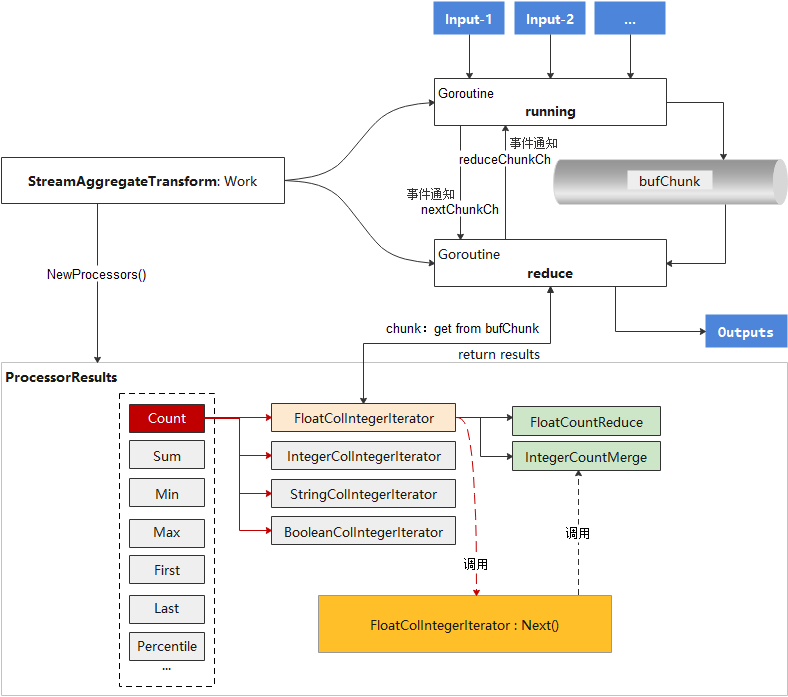openGemini时序数据库大解析:查询引擎框架
本文主要从源码层面解析openGemini的框架,并通过聚合函数的例子来分析其中一个算子(StreamAggregateTransform)的内部结构,对于新增算子开发是有帮助的。
openGemini查询引擎框架
openGemini的查询引擎的框架如图所示,分为两部分:查询语句编译系统和查询语句执行系统。
编译系统
Http Interface,监听客户端请求。openGemini对外提供HTTP RESTFULL接口,客户端将查询语句
SELECT count(water_level)
FROM h2o_feet
WHERE time > now()-1h
内部转化为HTTP消息发送到服务端(ts-sql),调用"/query"接口
curl -i -XPOST "http://localhost:8086/query" -k --insecure --data-urlencode "q=SELECT count(water_level) FROM h2o_feet WHERE time > now()-1h"
入口在open_src/influx/httpd/handler.go,h.serveQuery函数负责处理请求。核心代码如下:
func NewHandler(...) {
...
h.AddRoutes([]Route{
...
Route {
"query", // Query serving route.
"GET", "/query", true, true, h.serveQuery,
},
Route{
"query", // Query serving route.
"POST", "/query", true, true, h.serveQuery,
},
...
}
...
}
Parser And Compile,对查询语句进行合法性检查、词法分析、语法分析,编译生成抽象语法树(AST),新增的函数如果没有注册,在这里会被compileFunction函数检测到,报错 ERR: undefined function xxx,具体函数调用栈如下:
0 0x0000000000ecbe20 in github.com/openGemini/openGemini/open_src/influx/query.(*compiledField).compileFunction
at ./open_src/influx/query/compile.go:454
1 0x0000000000ecb3cb in github.com/openGemini/openGemini/open_src/influx/query.(*compiledField).compileExpr
at ./open_src/influx/query/compile.go:369
2 0x0000000000eca26b in github.com/openGemini/openGemini/open_src/influx/query.(*compiledStatement).compileFields
at ./open_src/influx/query/compile.go:272
3 0x0000000000ec9dc7 in github.com/openGemini/openGemini/open_src/influx/query.(*compiledStatement).compile
at ./open_src/influx/query/compile.go:212
4 0x0000000000ec9465 in github.com/openGemini/openGemini/open_src/influx/query.Compile
at ./open_src/influx/query/compile.go:129
5 0x0000000000edaae5 in github.com/openGemini/openGemini/open_src/influx/query.Prepare
at ./open_src/influx/query/select.go:125
6 0x00000000011f28f0 in github.com/openGemini/openGemini/engine/executor.Select
at ./engine/executor/select.go:49
Logical Plan Builder,根据时序数据库设计的逻辑算子和逻辑代数,从抽象语法树生成对应的逻辑计划。在这里相当于把一个个独立的逻辑算子(例如LogicalAggregate,LogicalLimit,LogicalJoin)组装在一起,共同完成查询语句所期望的功能。每一个逻辑算子对应一个物理算子(可以理解为真正计算的函数实体),所有聚合函数,比如count、min、max、mode,都归属于LogicalAggregate逻辑算子,LogicalAggregate对应的物理算子为StreamAggregateTransform, StreamAggregateTransform 的内部再分别实现count, min, max对应的功能。
查询计划与逻辑算子发生关联的地方在 engine/executor/logic_plan.go
func (b *LogicalPlanBuilderImpl) Aggregate() LogicalPlanBuilder {
last := b.stack.Pop()
plan := NewLogicalAggregate(last, b.schema) // 在这里
b.stack.Push(plan)
return b
}
调用栈如下:
0 0x00000000011a8069 in github.com/openGemini/openGemini/engine/executor.NewLogicalAggregate
at ./engine/executor/logic_plan.go:273
1 0x00000000011b5d55 in github.com/openGemini/openGemini/engine/executor.(*LogicalPlanBuilderImpl).Aggregate
at ./engine/executor/logic_plan.go:2235
2 0x00000000011f57c5 in github.com/openGemini/openGemini/engine/executor.buildAggNode
at ./engine/executor/select.go:343
3 0x00000000011f5a35 in github.com/openGemini/openGemini/engine/executor.buildNodes
at ./engine/executor/select.go:355
4 0x00000000011f5fa8 in github.com/openGemini/openGemini/engine/executor.buildQueryPlan
at ./engine/executor/select.go:424
5 0x00000000011f6134 in github.com/openGemini/openGemini/engine/executor.buildExtendedPlan
at ./engine/executor/select.go:431
6 0x00000000011f32b5 in github.com/openGemini/openGemini/engine/executor.(*preparedStatement).BuildLogicalPlan
at ./engine/executor/select.go:140
7 0x00000000011f37cc in github.com/openGemini/openGemini/engine/executor.(*preparedStatement).Select
at ./engine/executor/select.go:173
8 0x00000000011f2a0f in github.com/openGemini/openGemini/engine/executor.Select
at ./engine/executor/select.go:63
逻辑算子与物理算子关联的地方在 engine/executor/agg_transform.go
147: var _ = RegistryTransformCreator(&LogicalAggregate{}, &StreamAggregateTransformCreator{})
这是一个注册器,系统启动时执行,将LogicalAggregate与StreamAggregateTransform进行绑定。其他逻辑算子与物理算子也使用同样的方式绑定,比如:
var _ = RegistryTransformCreator(&LogicalGroupBy{}, &GroupByTransformCreator{})
Optimizer,启发式优化器,根据设计的代数规则,对逻辑计划进行基于规则的优化和重组。新增聚合算子暂时不涉及。
执行系统
DAG Builder, 将优化后的逻辑计划生成物理计划。可以简单理解为把逻辑算子替换成与之对应的物理算子(transformer),物理算子之间依赖关系用DAG(有向无环图)表示
Transformers, 所有物理执行算子的集合, 每个Transformer有输入和输出,这里的输入可以是最原始数据,也可以是其他Transformer的输出,这里的输出是Transformer的计算结果,可作为上一层Transformer的输入或者直接返回客户端的结果数据。
Pipeline Executor,采用流水线模式执行物理计划中的子任务,使用 DAG Scheduler 调度任务,保证任务执行的前后依赖关系。
DAG Scheduler,采用 work-stealing 算法调度物理计划(DAG),在任意时间保证最大任务并发度。
传统的执行计划都是串行执行,openGemini引入DAG的目的是让查询计划中的各个物理算子能并行的尽量并行起来,以此提升查询效率,该技术在ClickHouse和Flink中都有被用到。
如图所示,一个由DAG Builder产生的物理计划由A, B, C, D, E, F 6个Transformer组成,其中B和C依赖A,但互相不依赖,那么当A执行结束后,B和C就可以并行执行。DAG Scheduler的任务是效调度所有Transformer的前后执行关系以及并发处理,这是一个非常复杂的事情。openGemini巧妙利用Go语言的Goroutine和Channel特性完美解决了任务调度的问题,具体做法是遍历DAG,为每一条边创建一个单向Channel作为数据传输通道,边上的两个Transformer,例如Transformer A 和 Transformer B,Transformer A把计算结果写入Channel,Transformer B从Channel中取数据,如果Channel中没有数据,Transformer B则被阻塞。如此调度器则可以把所有的Transformer并发的运行起来,通过Channel的特性自动让位置靠后的Transformer处于阻塞状态,而一旦Channel中有数据会立刻被Golang调度执行。
物理计划主要由PipelineExecutor对象来执行,核心代码在 engine/executor/pipeline_executor.go, 核心方法是Executor(),代码如下:
func (exec *PipelineExecutor) Execute(ctx context.Context) error {
...
for _, p := range exec.processors {
go func(processor Processor) {
err := exec.work(processor)
if err != nil {
once.Do(func() {
processorErr = err
statistics.ExecutorStat.ExecFailed.Increase()
exec.Crash()
})
}
processor.FinishSpan()
wg.Done()
}(p)
}
...
}
func (exec *PipelineExecutor) work(processor Processor) error {
...
err := processor.Work(exec.context)
if err != nil {
...
}
return err
}
代码中Processor是一个接口,类似于一个基类,每个Transformer对象都实现了基类的work接口,这个work函数便是每个Transformer的入口。processor.Work() 相当于启动了Transformer。
Transformer之间的Channel是在PipelineExecutor初始化时完成的
func (exec *PipelineExecutor) init() {
exec.processors = make(Processors, 0, len(exec.dag.mapVertexToInfo))
for vertex, info := range exec.dag.mapVertexToInfo {
for i, edge := range info.backwardEdges {
_ = Connect(edge.from.transform.GetOutputs()[0], edge.to.transform.GetInputs()[i])
}
exec.processors = append(exec.processors, vertex.transform)
}
}
StreamAggregateTransform工作原理解析
这里我们以聚合算子为例剖析其内部实现,帮助理解如何开发一个物理算子或者在算子内部新增功能。
StreamAggregateTransform承载了所有聚合函数在openGemini内部的具体实现,先来看它的结构
type StreamAggregateTransform struct {
BaseProcessor
init bool //判断是否开始处理数据,在Transform退出之前检查该标志,以清空缓存
sameInterval bool //
prevSameInterval bool
prevChunkIntervalLen int
bufChunkNum int //缓存最大容量
proRes *processorResults //上一轮处理结果缓存
iteratorParam *IteratorParams //迭代器参数
chunkPool *CircularChunkPool //存放结果数据的池子
newChunk Chunk //承载从chunkpool中拿到的chunk. trans.newChunk = trans.chunkPool.GetChunk()
nextChunkCh chan struct{} //用于事件通知,通过写入通知数据接收协程继续接收数据到缓存中
reduceChunkCh chan struct{} //用于事件通知,通过写入通知数据处理协程从缓存中拿数据处理
bufChunk []Chunk //数据缓存,从Inputs中读取待处理数据,缓存在bufChunk中。
Inputs ChunkPorts //Transformer的输入管道
Outputs ChunkPorts //Transformer的输出管道
opt *query.ProcessorOptions
aggLogger *logger.Logger
postProcess func(Chunk)
span *tracing.Span //用于信息统计使用,比如Explain命令
computeSpan *tracing.Span //用于信息统计使用,比如Explain命令
errs errno.Errs
}
StreamAggregateTransform内部工作原理
如图所示,StreamAggregateTransform在初始化是将创建一个ProcessorResults的对象,在ProcessorResults中,会根据不同聚合函数分别注册一系列的迭代器(比如FloatColIntegerIterator,StringColIntegerIterator)和数据处理方法(比如FloatCountReduce和IntegerCountMerge),每个迭代器(Iterator)有一个Next()方法,这个方法才是聚合函数功能的具体实现,其中会使用到事先注册的数据处理方法(比如FloatCountReduce和IntegerCountMerge)
StreamAggregateTransform的入口是Work()函数,核心功能并发启动running和reduce两个模块,running负责取数据,reduce负责调用之前已经注册好的迭代器进行聚合数据处理,并返回。
StreamAggregateTransform工作原理的源码解析
StreamAggregateTransform初始化在 engine/executor/agg_transform.go,核心代码如下:
func NewStreamAggregateTransform(
inRowDataType, outRowDataType []hybridqp.RowDataType, exprOpt []hybridqp.ExprOptions, opt *query.ProcessorOptions, isSubQuery bool,
) (*StreamAggregateTransform, error) {
...
trans := &StreamAggregateTransform{
opt: opt,
bufChunkNum: AggBufChunkNum,
Inputs: make(ChunkPorts, 0, len(inRowDataType)),
Outputs: make(ChunkPorts, 0, len(outRowDataType)),
bufChunk: make([]Chunk, 0, AggBufChunkNum), //这里规定了bufChunk的容量
nextChunkCh: make(chan struct{}),
reduceChunkCh: make(chan struct{}),
iteratorParam: &IteratorParams{},
aggLogger: logger.NewLogger(errno.ModuleQueryEngine),
chunkPool: NewCircularChunkPool(CircularChunkNum, NewChunkBuilder(outRowDataType[0])),
}
...
//这里初始化的trans.proRes对象,NewProcessors()完成了各类迭代器的注册,新增聚合函数需要在这里实现迭代器方法和注册
trans.proRes, err = NewProcessors(inRowDataType[0], outRowDataType[0], exprOpt, opt, isSubQuery)
...
}
Work() 的核心代码如下:
func (trans *StreamAggregateTransform) Work(ctx context.Context) error {
...
for i := range trans.Inputs {
go trans.runnable(i, ctx, errs) //每个Input对应一个runing协程,实则只有一个Input,预留了多个而已
}
go trans.reduce(ctx, errs) //开一个reduce协程
return errs.Err()
}
running和reduce模块的核心代码如下:
func (trans *StreamAggregateTransform) runnable(in int, ctx context.Context, errs *errno.Errs) {
...
trans.running(ctx, in)
}
//running协程
func (trans *StreamAggregateTransform) running(ctx context.Context, in int) {
for {
select {
case c, ok := <-trans.Inputs[in].State:
...
trans.init = true
trans.appendChunk(c) //放入缓存
if len(trans.bufChunk) == trans.bufChunkNum { //缓存满了就通知reduce处理数据
trans.reduceChunkCh <- struct{}{}
}
<-trans.nextChunkCh //放一个chunk到缓存,等待reduce消费的信号
...
case <-ctx.Done():
return
}
}
}
//reduce协程
func (trans *StreamAggregateTransform) reduce(_ context.Context, errs *errno.Errs,) {
...
// return true if transform is canceled
reduceStart := func() {
<-trans.reduceChunkCh
}
// return true if transform is canceled
nextStart := func() {
trans.nextChunkCh <- struct{}{}
}
trans.newChunk = trans.chunkPool.GetChunk() //从池子中分配一片空间
for {
nextStart() //通知running继续往缓存放数据
reduceStart() //消费管道里的事件通知,如果running还没给消息,阻塞在这里等待
c := trans.nextChunk() //从缓存中取一个chunk(数据处理单位),1个chunk包含多行(rows)数据
...
tracing.SpanElapsed(trans.computeSpan, func() {
trans.compute(c) //在compute方法中处理chunk数据,最终会调到具体的一个迭代器来完成
...
})
}
}
running模块主要完成从Input读取数据,放入缓存,通知Reduce处理。Reduce负责调用具体的迭代器来处理数据。Running和Reduce之间通过两个单向管道(nextChunkCh和reduceChunkCh)进行事件通知。
聚合函数的迭代器和处理方法注册的源码解析
NewProcessors()的实现在engine/executor/call_processor.go,主要完成了各聚合函数的迭代器和数据处理方法的注册,新增聚合函数需要在这里实现迭代器方法和注册, 核心代码如下:
func NewProcessors(inRowDataType, outRowDataType hybridqp.RowDataType, exprOpt []hybridqp.ExprOptions, opt *query.ProcessorOptions, isSubQuery bool) (*processorResults, error) {
...
for i := range exprOpt {
...
switch expr := exprOpt[i].Expr.(type) {
case *influxql.Call:
...
name := exprOpt[i].Expr.(*influxql.Call).Name
switch name {
case "count":
//聚合函数count走这里,在NewCountRoutineImpl方法中注册
routine, err = NewCountRoutineImpl(inRowDataType, outRowDataType, exprOpt[i], isSingleCall)
coProcessor.AppendRoutine(routine)
case "sum":
routine, err = NewSumRoutineImpl(inRowDataType, outRowDataType, exprOpt[i], isSingleCall)
coProcessor.AppendRoutine(routine)
case "first":
...
case "last":
...
case "min":
...
case "max":
...
case "percentile":
...
case "percentile_approx", "ogsketch_percentile", "ogsketch_merge", "ogsketch_insert":
...
case "median":
...
case "mode":
...
case "top":
..
case "bottom":
...
case "distinct":
...
case "difference", "non_negative_difference":
...
case "derivative", "non_negative_derivative":
...
case "elapsed":
...
case "moving_average":
...
case "cumulative_sum":
...
case "integral":
...
case "rate", "irate":
...
case "absent":
...
case "stddev":
...
case "sample":
...
default:
return nil, errors.New("unsupported aggregation operator of call processor")
}
...
}
...
}
NewCountRoutineImpl方法的实现在engine/executor/call_processor.go,核心代码如下:
func NewCountRoutineImpl(inRowDataType, outRowDataType hybridqp.RowDataType, opt hybridqp.ExprOptions, isSingleCall bool) (Routine, error) {
...
dataType := inRowDataType.Field(inOrdinal).Expr.(*influxql.VarRef).Type
switch dataType {
case influxql.Integer: //聚合的字段是整型
return NewRoutineImpl(
NewIntegerColIntegerIterator(IntegerCountReduce, IntegerCountMerge, isSingleCall, inOrdinal, outOrdinal, nil, nil), inOrdinal, outOrdinal), nil
case influxql.Float: //聚合的字段是浮点型
return NewRoutineImpl(
NewFloatColIntegerIterator(FloatCountReduce, IntegerCountMerge, isSingleCall, inOrdinal, outOrdinal, nil, nil), inOrdinal, outOrdinal), nil
case influxql.String: //聚合的字段是字符串
return NewRoutineImpl(
NewStringColIntegerIterator(StringCountReduce, IntegerCountMerge, isSingleCall, inOrdinal, outOrdinal, nil, nil), inOrdinal, outOrdinal), nil
case influxql.Boolean: //聚合的字段是布尔型
return NewRoutineImpl(
NewBooleanColIntegerIterator(BooleanCountReduce, IntegerCountMerge, isSingleCall, inOrdinal, outOrdinal, nil, nil), inOrdinal, outOrdinal), nil
}
}
因为不同数据类型,数据处理方式不同,因此要适配不同的迭代器。比如有如下数据:
h2o_feet,location=coyote_creek water_level=8.120,description="between 6 and 9 feet" 1566000000000000000
h2o_feet,location=coyote_creek water_level=8.005,description="between 6 and 9 feet" 1566000360000000000
h2o_feet,location=coyote_creek water_level=7.887,description="between 6 and 9 feet" 1566000720000000000
h2o_feet,location=coyote_creek water_level=7.762,description="between 6 and 9 feet" 1566001080000000000
h2o_feet,location=coyote_creek water_level=7.635,description="between 6 and 9 feet" 1566001440000000000
查询语句
1. SELECT count(water_level) FROM h2o_feet
2. SELECT count(description) FROM h2o_feet
water_level是浮点型,就用FloatColIntegerIterator,如果是description,则用StringColIntegerIterator
每个迭代器必须包含一个Reduce和Merge方法。具体什么作用?以FloatCountReduce和IntegerCountMerge举例
/*
c,包含待处理数据的chunk
ordinal, 指定chunk中的数据列
star,表示chunk中数据分组的起始位置。比如查询是按时间分组再统计
end,表示chunk中数据分组的结束位置。比如查询是按时间分组再统计。如果查询没有分组,那么chunk中所有数据都属于一个分组
*/
func FloatCountReduce(c Chunk, ordinal, start, end int) (int, int64, bool) {
var count int64
//ordinal指定要计算chunk中第几列数据。如果指定列的数据都没有空值,直接用end-start快速计算count值
if c.Column(ordinal).NilCount() == 0 {
// fast path
count = int64(end - start)
return start, count, count == 0
}
//如果数据列中有空值,就要换一种计算方法
vs, ve := c.Column(ordinal).GetRangeValueIndexV2(start, end)
count = int64(ve - vs)
return start, count, count == 0
}
//merge方法是做一个累计求和,把上一个chunk中统计的count值 + 当前求得的count值。因为chunk中数据量是一定的,要统计的数据可能分成了很多个chunk
func IntegerCountMerge(prevPoint, currPoint *IntegerPoint) {
...
prevPoint.value += currPoint.value
}
Chunk数据结构解析
Chunk可以被看着是一张表,是Transformer之间数据传输和数据处理的最小单位,是向量化的重要载体。
Chunk结构体定义如下:
type ChunkImpl struct {
rowDataType hybridqp.RowDataType
name string
tags []ChunkTags
tagIndex []int
time []int64
intervalIndex []int
columns []Column
dims []Column
*record.Record
}
举个例子,用同样的数据:
h2o_feet,location=coyote_creek water_level=8.120,description="between 6 and 9 feet" 1566000000000000000
h2o_feet,location=coyote_creek water_level=8.005,description="between 6 and 9 feet" 1566000360000000000
h2o_feet,location=coyote_creek water_level=7.887,description="between 6 and 9 feet" 1566000720000000000
h2o_feet,location=coyote_creek water_level=7.762,description="between 6 and 9 feet" 1566001080000000000
h2o_feet,location=coyote_creek water_level=7.635,description="between 6 and 9 feet" 1566001440000000000
查询语句
> SHOW TAG KEYS
name: h2o_feet
tagKey
------
location
> SELECT count(water_level) FROM h2o_feet WHERE time >= 1566000000000000000 AND time <= 1566001440000000000 GROUP By time(12m)
name: h2o_feet
time count
---- -----
1566000000000000000 2
1566000720000000000 2
1566001440000000000 1
摘取其一个StreamAggregateTransform接收到的Chunk,查看内部具体组成
迭代器Next方法解析
以FloatColIntegerIterator为例, 在engine/executor/agg_iterator.gen.go, Next()方法的核心代码如下:
func (r *FloatColIntegerIterator) Next(ie *IteratorEndpoint, p *IteratorParams) {
//inChunk存储待处理数据,即StreamAggregateTransform接收到的Chunk最终在这里被处理,outChunk存储处理后的结果数据
inChunk, outChunk := ie.InputPoint.Chunk, ie.OutputPoint.Chunk
//inOrdinal是一个位置信息,初始为0,遍历chunk中的所有列。当前例子中chunk只有1列
//这里判断列是否为空,如果为空,需要给这些列数据用nil填充
if inChunk.Column(r.inOrdinal).IsEmpty() && r.prevPoint.isNil {
var addIntervalLen int
if p.sameInterval {
addIntervalLen = inChunk.IntervalLen() - 1
} else {
addIntervalLen = inChunk.IntervalLen()
}
if addIntervalLen > 0 {
outChunk.Column(r.outOrdinal).AppendManyNil(addIntervalLen)
}
return
}
var end int
firstIndex, lastIndex := 0, len(inChunk.IntervalIndex())-1
//[start,end]代表一个分组数据,分组数据是chunk数据的一个子集
for i, start := range inChunk.IntervalIndex() {
if i < lastIndex {
end = inChunk.IntervalIndex()[i+1]
} else {
end = inChunk.NumberOfRows()
}
//fn为FloatCountReduce方法
index, value, isNil := r.fn(inChunk, r.inOrdinal, start, end)
if isNil && ((i > firstIndex && i < lastIndex) ||
(firstIndex == lastIndex && r.prevPoint.isNil && !p.sameInterval) ||
(firstIndex != lastIndex && i == firstIndex && r.prevPoint.isNil) ||
(firstIndex != lastIndex && i == lastIndex && !p.sameInterval)) {
outChunk.Column(r.outOrdinal).AppendNil()
continue
}
//这里主要是处理三种情况
//1. 分组数据跨两个chunk,当前chunk的前面部分数据与上一个chunk的最后部分数据属于一个分组,
// 当前计算结果需要加前一个数据的结果,调用fv: FloatCountmerge方法
//2. 分组数据跨两个chunk,当前chunk的后面部分数据与下一个chunk的最前面部分数据属于一个分组,
// 当前计算结果需要缓存起来
//3. 分组数据不跨chunk,计算结果为最终结果
if i == firstIndex && !r.prevPoint.isNil {
r.processFirstWindow(inChunk, outChunk, isNil, p.sameInterval,
firstIndex == lastIndex, index, value)
} else if i == lastIndex && p.sameInterval {
r.processLastWindow(inChunk, index, isNil, value)
} else if !isNil {
r.processMiddleWindow(inChunk, outChunk, index, value)
}
}
}
总结
本文展示了openGemini的部分核心代码,对查询引擎的框架做了深度解析,并详细介绍了StreamAggregateTransform工作原理,希望能对大家阅读源码和使用数据库时有所帮助。
openGemini官网:http://www.openGemini.org
openGemini开源地址:https://github.com/openGemini
openGemini公众号:
欢迎关注~ 诚邀你加入 openGemini 社区,共建、共治、共享未来!










